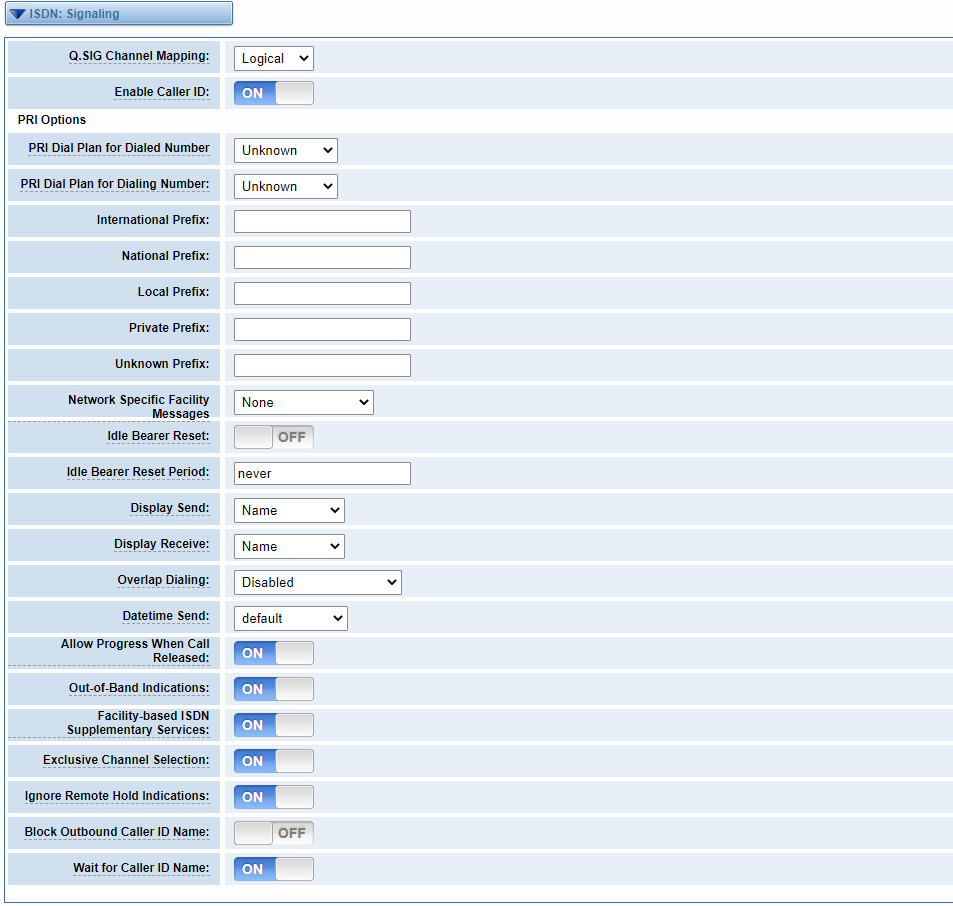How to configure PRI signalling
Port Details
E1/T1 generic interface selection PRI (CPE side)
There is a crc4 (cyclic redundancy check) parameter on this page that needs to be noted. The parameter is turned off by default, and whether it is turned on or not needs to be confirmed with the docked carrier to be consistent.

| Settings | Description |
|---|---|
| Timing Source | Timing Source indicate the ports as to which should be used to recover the clock.(0 for master mode, upper for client mode, small number have higher priority ) |
| Interface | Choose a line type for the interface. |
| Framing | Select the frame format according to the country and operator (or peer) requirements. The frame format of the gateway must match that of the carrier (or peer), otherwise the link may not be able to establish the frame format of the trunk.
|
| Coding | Select the line code for the trunk according to the country and the carrier’s (or peer’s) requirements.
|
| Line Build-out | The external cable represents the length of cable wire from this gateway’s port to the next device. |
| CRC4 | Enable cyclic redundancy online error checking. In Europe CRC-4 needs to support all network switches, but many older switches and PBXs do not support it. |
| Signaling | Show the signaling used by the port. |
| Switch Type | Please set it according to the properties of the Carrier or Peer, and it should be the same conversion type.
|

| Settings | Description |
| Q.SIG Channel Mapping | Sets logical or physical channel mapping. In logical channel mapping, channels are mapped to 1-30.In physical channel mapping, channels are mapped to 1-15,17-31,skipping the number used for the data channel, Default is physical. |
| Enable Caller ID | Whether or not to use caller ID |
| PRI Dial Plan for Dialed Number | PRI Dialplan: The ISDN-levei Type of Number (TON) or numbering plan, used for the dialed number. Leaving this as ‘unknown’ (the default) works for most cases. In some very unusual circumstances, you may need to set this to; ’dynamic’ or ‘redundant’ |
| PRI Dial Plan for Dialing Number | PRI Local Dialplan: Only RARELY used for PRI(sets the calling number’s numbering plan).In North America, the typical use is sending the 10 digit; caller ID number and setting the prilocaldialplan to ‘national’ (the default).Only VERY rarely will you need to change this. |
| Network Specific Facility (NSF) Messages | Some switches (AT&T especially) require network specific facility IE. Supported values are currently ‘none’,’sdn’,’ megacom’,’ tollfreemgacom’, ’ account’ |
| Idle Bearer Reset | Whether or not to reset unused B channels |
| Idle Bearer Reset Period | Sets the time in seconds between restart of unused B channels; defaults to ‘never’ |
| Display Send | Send/receive ISDN display IE options, the display options are a comma separated list of the following options:
Block: Do not pass display text data. Name_ initial: Use display text in SETUP/CONNECT messages as the party name. Name_ update: Use display text in other messages (NOTIFY/FACILITY)for COLP name update. Name: Combined name_ initial and name_ update options. Text: Pas any unused display text data as an arbitrary display message during a call. Sent text goes out in default to ‘name’ |
| Display Receive | Send/receive ISDN display IE options. The display options are a comma separated list of the following options:
Block: Do not pass display text data. Name_ initial: Use display text in SETUP/CONNECT messages as the party name. Name_ update: Use display text in other messages (NOTIFY/FACILITY) for COLP name update. Name: Combined name_ initial and name_ update options. Text: Pas any unused display text data as an arbitrary display message during a call. Sent text goes out in default to ‘name’ |
| Overlap Dialing | Enable overlap dialing mode–sending overlap digits. |
| Allow Progress When Call Released | Allow inband audio (progress) when a call is DISCONNECT Ted by the end of a PRI |
| Out-of-Band Indications | PRI Out of band indications. Enable this to report Busy and congestion on a PRI using out_ of_ band notification. Inband indication, as used by the gateway doesn’t seem to work with all telcos. |
| Facility-based ISDN Supplementary Services | To enable transmission of facility-based ISDN supplementary services (such as caller name form CPE over facility), enable this option. Cannot be changed on a reload. |
| Exclusive Channel Selection | If you need to override the existing channels selection routine and force all PRI channels to be marked as exclusively selected, set this to yes. priexclusive cannot be changed on a reload. |
| Ignore Remote Hold Indications | If you wish to ignore remote hold indications (and use MOH that is supplied over the B channel) enable this option. |
| Block Outbound Caller ID Name | Enable if you need to hide just the name and the number for legacy PBX use. Only applies to PRI channels. |
| Wait for Caller ID Name | Support caller ID on call waiting |
